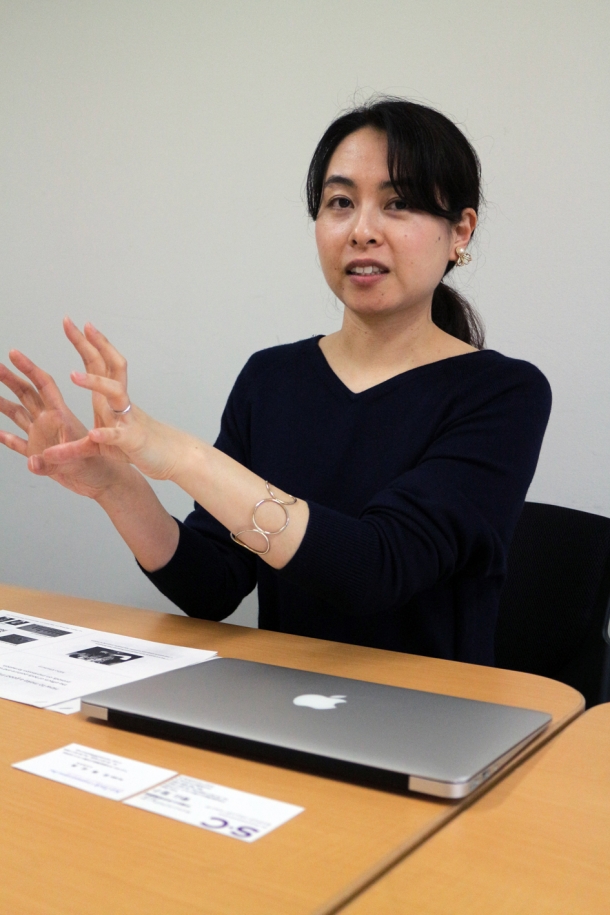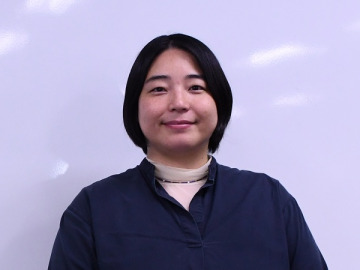
Impressions Influence Relationships
People instantaneously form impressions of others—even during their very first meeting—based on the slightest fragments of information, such as small gestures or facial expressions. We use these impressions as clues to determine what kind of person the other party is, how they are likely to behave, and to decide how to interact with them accordingly. Impressions are a crucial factor in building relationships with others. I am studying how these impressions are formed, particularly how nonverbal information such as posture and voice influence impression formation.
You may perhaps think of “impressions” merely in terms of paying extra attention to them in the context of business or romance situations. However, impressions are something more primal than that. Humans are social creatures, and whether or not we can communicate smoothly with strangers can radically alter our lives. To state things in a somewhat exaggerated way, it could be a life-or-death issue. It is therefore important to get a reasonably accurate impression of someone in a short period of time and to make a good impression on that person in turn. We can safely assume that the capacity to create good impressions and to form impressions of others is something that humans have acquired to survive within societies.
Recent research has demonstrated that the first impression of someone correlates to that person’s success. For example, reports have shown that the impressions formed by subjects viewing photographs of electoral candidates match the actual election results. This illustrates that even judgments that we ought to make based on policies and political positions—judgments we think we are making based on these factors—are, in fact, strongly influenced by our appearance-based impressions. Furthermore, creating a good impression increases positive would feedback from others, heightening our own motivation and often ultimately leading to the achievement of social success. This means that what begins as mere appearance can end up being accompanied by real ability. Therefore, leaving others with a good impression provides benefits to our lives as members of a society which are too great to be ignored.
Making Yourself Look Good
Impressions are formed in a matter of seconds, even before a conversation begins. Many psychological studies have stated that people with handsome faces or good figures are attractive and leave a good impression. However, very few individuals have faces or figures attractive enough to stand out from the crowd. Many people, therefore, work to present themselves in an attractive way. The vast amounts of money spent on weight loss, makeup, and plastic surgery tell us as much.
However, in reality, there are numerous ways of improving the impression we leave on others without spending an enormous amount of money and efforts. Although it may seem like stating the obvious, things like smiling, making eye contact, and assuming good posture can effectively leave a positive impression. The impression we leave on others is largely comprised of bodily and nonverbal information such as posture, voice, and expressions. To an extent, these things are expressed automatically and we therefore tend to not pay much conscious attention to them. However, a small amount of conscious attention to these factors allows us a certain amount of control over the impression that we leave on others.
Posture Comes Across Instantly
A recent study on posture confirms that it is observed instantly. Posturing is one of the behaviors by which all creatures understand each other and a vital part of how animals that cannot verbally express themselves show power relationships within their in-groups. For example, by hunching its back, one animal shows another that it considers itself of lower status and is willing to submit.
I am sure that many people have been advised to “sit up straight” before an interview. We all intuitively know that better posture makes for a better impression, but there has been surprisingly little systematic research into the particulars of the relationship between posture and image formation, such as the length of time required to influence impressions of trustworthiness or attractiveness.
To address this gap in the literature, my research partners and I asked college students to exhibit both good posture and bad posture while we photographed them. Next, we asked different college students to rate the people in the photographs on “attractiveness,” “trustworthiness,” and “dominance.” Because we did not dictate any specific poses, the “good” postures and “bad” postures varied according to the individual’s perception. However, all of the postures intended to be “good” postures were rated higher than the ones intended to be “bad,” especially in terms of trustworthiness. This finding shows that a change in posture can effectively improve others’ impression of a person, even without any particular postural training. When we changed the amount of time the photographs were shown to the subjects before rating them to determine how long good impressions took to form, we found that impressions were formed in an extremely short time; just 0.1 seconds. It is clear that posture is perceived by others and an impression formed in a mere split second.
Mental States Change According to Voice
We have started studying voice as well. Emotions are strongly reflected in the voice, and our emotions and situations come across in our voices without our conscious awareness. In communication between two people, the parties read each other’s emotions and circumstances through their voices to form impressions, and sometimes, one party may even infect the other with those emotions during the conversation. To empirically investigate the mechanism behind this effect would require altering voices along specified emotional trajectories in real time. Because this is technologically difficult to accomplish, there has not been much research progress in this area. In 2016, a team led by Professor Katsumi Watanabe of the Waseda University Faculty of Science and Engineering, which I was formerly affiliated with and still collaborate for research, made this research possible with the development of a device called DAVID (Da Amazing Voice Inflection Device, see image). DAVID can use a digital platform to adjust a speaker’s vocal intonation, rhythm, and other emotional cues (in other words, their prosody) into cues expressing “happiness,” “sadness,” or “fear,” among others. With this device, a speaker’s voice volume and manner of speaking can be left as-is while changing only the emotional aspects. DAVID also allows two people’s voices to be changed in the same emotional direction at the same time, or alternatively in opposite directions, enabling a detailed examination of how vocal emotion influences behaviors like image formation and decision-making between two people.
Several preliminary experiments are currently underway. In a recent study, manuscripts about the fictional “A-san” describing behavior designed to elicit “good,” “average,” or “bad” impressions were read aloud to listeners in either a happy-sounding voice or a sad-sounding voice, after which I recorded the listeners’ impressions of A-san. I found that the difference in voice had hardly any effect on their impressions of the “normal” behavior but hearing about behavior which would normally lead to a negative impression in a happy-sounding voice improved their impressions. Additionally, hearing about behavior which would lead to a good impression in a sad-sounding voice left them with a bad impression. This shows that vocal prosody is capable of affecting a listener’s impression of the content of an utterance. Therefore, not only the content of the linguistic information, but also “how it is told to the listener” is important. I have also started several other experiments and while they are still in the preliminary stages, we will continue aiming to make progress in this area.

Image: A digital platform that can add emotional expressions to voices while an individual is talking (DAVID; Da Amazing Voice Inflection Device (Aucouturier et al., 2016)
http://cream.ircam.fr/?p=44)
Emotions Come Across
My impetus for pursuing psychological research came from my experience of majoring in piano at a music high school. I had always wondered why I was so emotionally moved when I played the piano, as well as why during concerts, the orchestra would synchronize with the pianist’s emotions, and those emotions would come across to the audience as well. In college, I met a psychology instructor and I started researching the relationship between emotion and sensibility. I discovered that when people look at a painting, the parts of their brains associated with sight and other senses are activated, and when they are in a bright “I feel rosy” mood, the way they see the outside world (sense of sight) is affected.
Since coming to Waseda University, I have been studying the effects of bodily information—such as voice and posture—on communication. My current research into posture and prosody involves experiments on human subjects, but in the future, I believe it may be possible to apply this type of research to communication between humans and robots as well. My goal is to contribute to creating a better society by shedding light on the role of physicality in communication.
Interview and Composition: Narumi Sato
In cooperation with: Waseda University Graduate School of Political Science J-School










